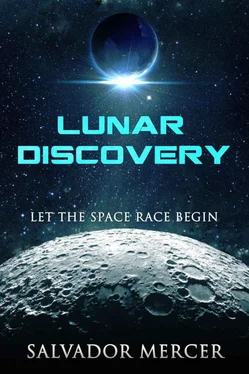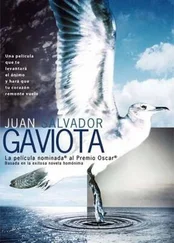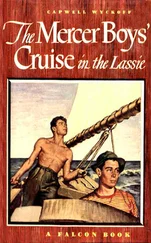Mr. Smith frowned. This was one of those rarer times when Rock’s team was blessed with the presence of both security officials. Usually, Mr. Smith roved between the three teams at NASA headquarters while Mrs. Brown seemed to be assigned specially for the mission team.
Jeff and his engineers were on the near wing working the equipment while across the building the academia and scientists were analyzing the signals and data from the alien device. Rock had reason on more than one occasion to visit Jeff and his team down the hall, and he noticed a “suit,” as Tom called them, assigned to the equipment team. It seemed all three groups had security personal assigned to them with Mr. Smith managing the effort.
“I’m just taking notes,” Mrs. Brown said, never looking up from her writing.
“Is it true the president sees all your notes?” Jack asked.
“It’s not important what information is passed on. What is important is that we find a way to get to the moon with a manned craft quicker than the Russians or the Chinese. Personally, I wouldn’t share this information with you—need to know—but I’ve been overruled. So you have the latest intel on our adversaries, and you’re tasked with using it to assist you in formulating and tweaking your plan, nothing more,” Mr. Smith said.
Rock knew the president personally overrode the NSA’s objections, but decided gloating or goading his handler would accomplish nothing. “All right, people, what does this mean for our mission? How does this affect the parameters of our launch?”
“Well, it gives us a bit more time,” Marge said.
“And we know what they’re waiting on,” Jack added.
“So if Lisa’s right, they would need some sort of navigation or control pod to add to their station.” Rock looked at his team. “Their current station doesn’t allow them forward viewing, so until that is fixed, they are stuck in orbit. Low or high, it doesn’t matter.”
“Why do they need to see anything?” Mrs. Brown paused her note-taking to ask. “Why not fly this thing sideways? Would it matter?”
“Yeah, why not use those side portholes to line up their lunar approach and insert into orbit using a fixed view finder that way? I’m sure they could bring one up from planet-side easily enough,” Jack asked.
“Impossible,” Jeff chimed in, his rare voice being heard among the group. “The entire station is structured along those two primary load bearing I-beams, right, Craig? Julie?” he asked the astronauts, pausing long enough to see them nod. “So any rockets capable of providing enough thrust to exit the earth’s orbit would have to be larger than normal vectoring motors, and I’m pretty sure the only place to mount them would be along the x-axis, horizontally.”
Craig jumped in. “Exactly. The shorter y-axis beams are only used for providing cross structure strength. They would not bear a load very well, and I’m not sure they could support a sustained rocket burn.”
Mr. Smith looked annoyed. “What does this all mean in layman’s terms?” He always reverted to that phrase when confronted with what was commonly thought of as techno-babble , Rock thought.
“It means, Mr. Smith,” Marge interjected, “that the Russian space station can only travel to the moon front first or rear first. Not sideways. They still need a steering wheel.” Marge smiled to Lisa, and Rock was surprised to see the gesture returned. Were the two actually working together better? That would be a most welcome development , Rock thought to himself.
“I still don’t see why they need to see visually,” Mrs. Brown said, resuming her note-taking while asking the question.
“Because the insertion window for lunar orbit is relatively narrow,” Lisa said. “Less than one degree, if my calculations are correct.”
“They are,” Marge said, again uncharacteristically friendly to Lisa.
“So if they are out of alignment by even half a degree, then they could be flung past the moon and end up either sailing off into intra-solar space or worse, be directed inward toward the sun. With very limited fuel, there would be no escaping that gravity well,” Lisa said.
“Either that, or end up auguring into the lunar surface,” Jack said.
“Then it would be adios , muchachos , to borrow a line.” Tom chuckled.
“Why not just put cameras on the front and be done with it?” Mrs. Brown asked, again pressing her questions seemingly in support of her report.
“Because they don’t know what took out the Chinese equipment,” Marge followed up. “Neither do we, so if their camera system goes down, they would be flying blind.”
Tom leaned forward for emphasis. “They could fly that bad boy old school with just an HUD on the forward viewport like we did the Apollo missions. As long as they have the HUD calibrated, there is no need for cameras.”
“And if the HUD goes down?” Mr. Smith asked.
“They use an overlay on the glass, measured from the pilot’s seat. No electronics required,” Tom answered.
“You getting all this?” Mr. Smith asked Mrs. Brown.
“I have it. I’ll compile it and send it to headquarters within the hour,” she responded.
“So what do you think the Russians are doing?” Jeff asked.
“Getting ready to place a steering wheel on their station,” Rock answered.
* * * * *
Gordust Space Station
Low Earth Orbit
In the near future, Day 25
Yuri watched as the remains of the mice were jettisoned along with several boxes of American instruments and equipment. One would have thought that Olga had some kind of compassion within her soul, but she was ready to jettison the mammals into space alive. Yuri had to insist as senior commander that she euthanize them first. Luckily they still had a fair amount of ether that the American female astronaut had used to knock the mice unconscious when handling them. Olga dumped most of the ether into an absorbent rag inside their cage and sealed it. The creatures fell asleep and passed within minutes. The ants weren’t so lucky.
Better if the woman had taken them back to earth with her, but they had to keep up pretenses and maintain the façade that they were going to continue with her science projects until a return of an American crewmember. That also gave the diplomats earth-side some cover since they could maintain that by monitoring the American experiments, they were still technically abiding by the terms of the station’s joint use agreement. Yuri was sure that wasn’t going to fly anymore.
He moved over to the port window, watching as Gregori and Nikolai were attaching the space rocket to the long support beam. He was the only person certified to operate the long central robotic arm that was similar to what the old U.S. space shuttle had, except more than twice as long, and it had three times the strength in its hydraulic motors. The last couple of days, Yuri had used the arm to bring the personnel pods into the inner rails, making room for the large rockets.
This had brought another set of issues as the living pods were equipped with radiative fins to disperse heat. Despite the fact that space was neither hot nor cold, a common misunderstanding by most, their main issue was radiating heat away from the station, especially when they were on the sun’s side of the earth. Pulling the pods closer to the station made it harder to radiate excess heat, and Yuri had already noticed a slight increase in the overall average internal temperature range. It increased by nearly half a degree Celsius. It would get worse by another quarter of a degree when the four cosmonauts were primarily inside the craft as their cumulative body heat added to the overall temperature of the station.
Читать дальше












